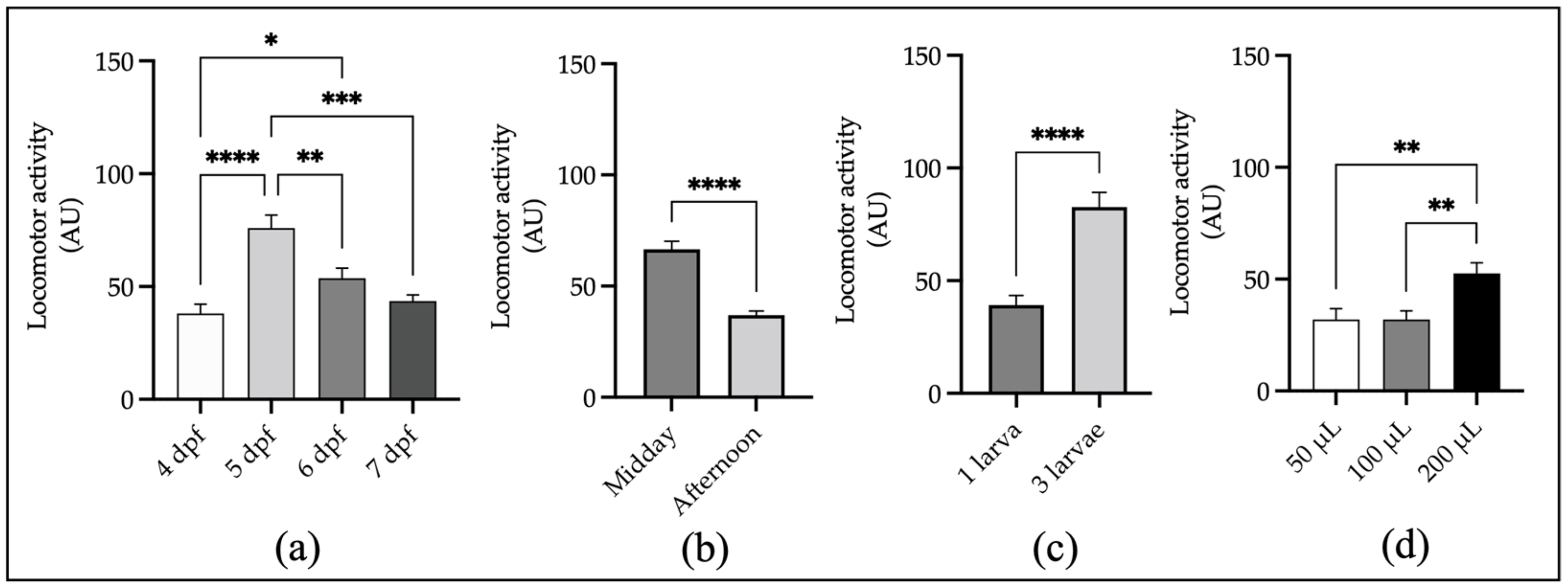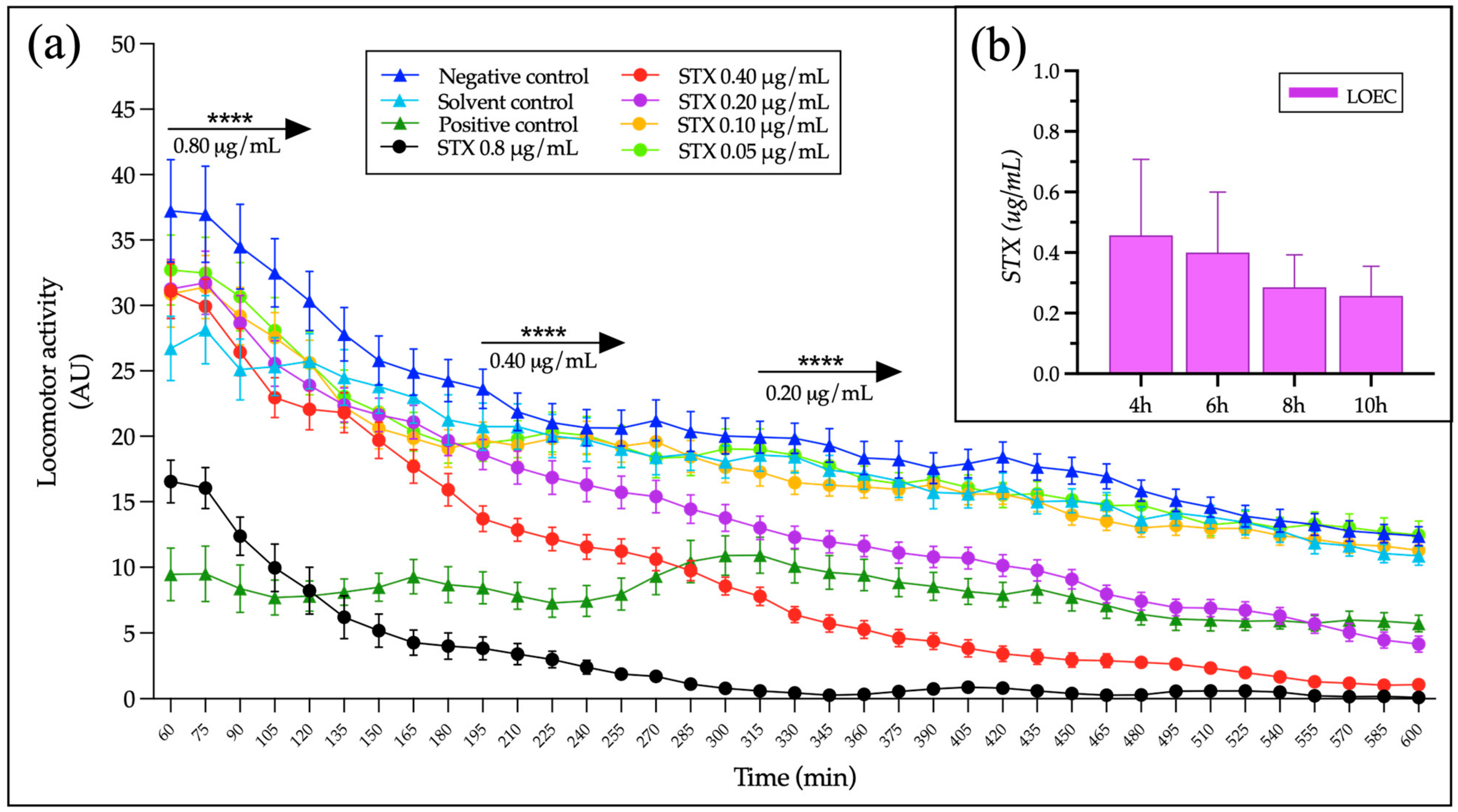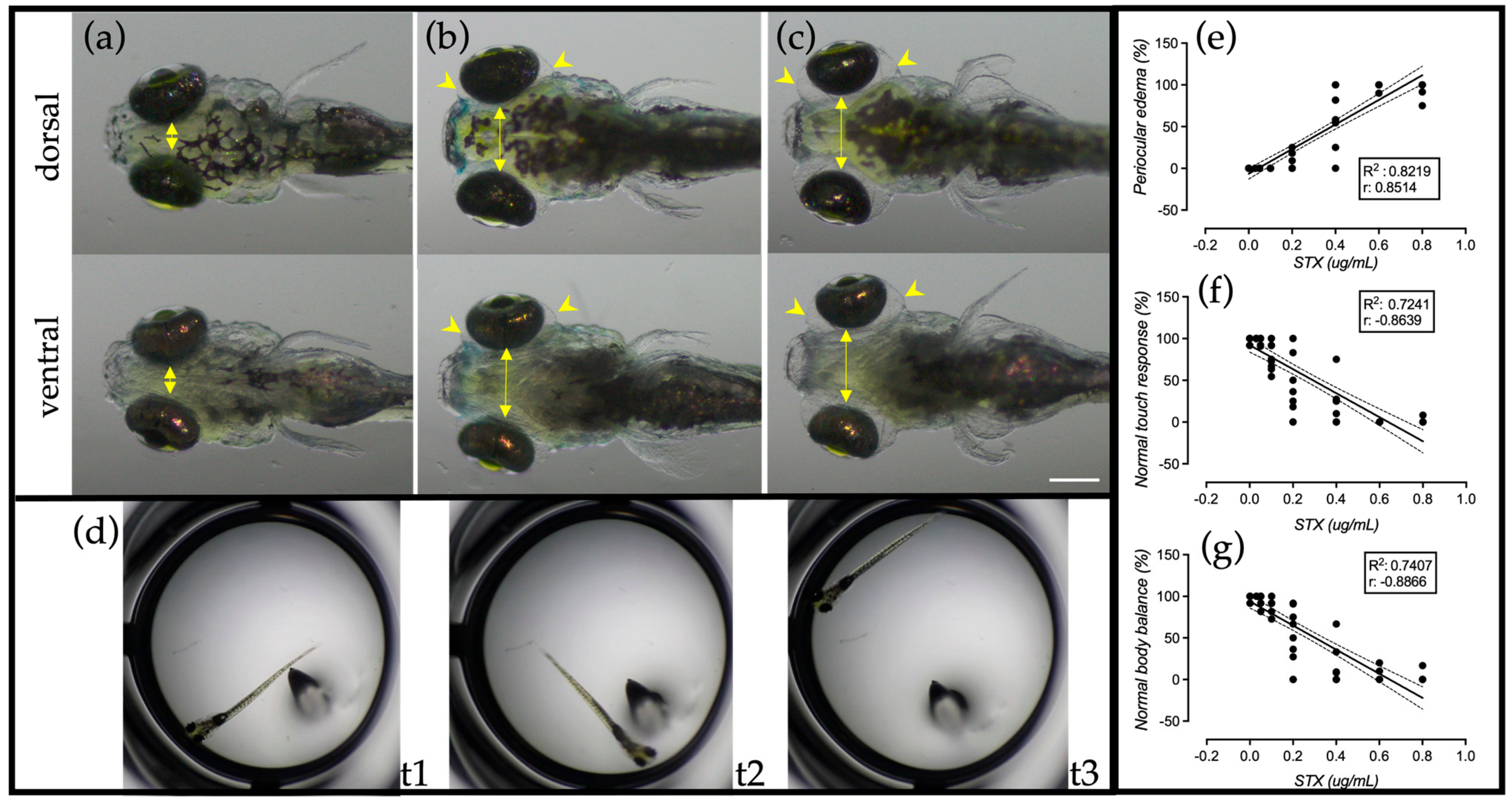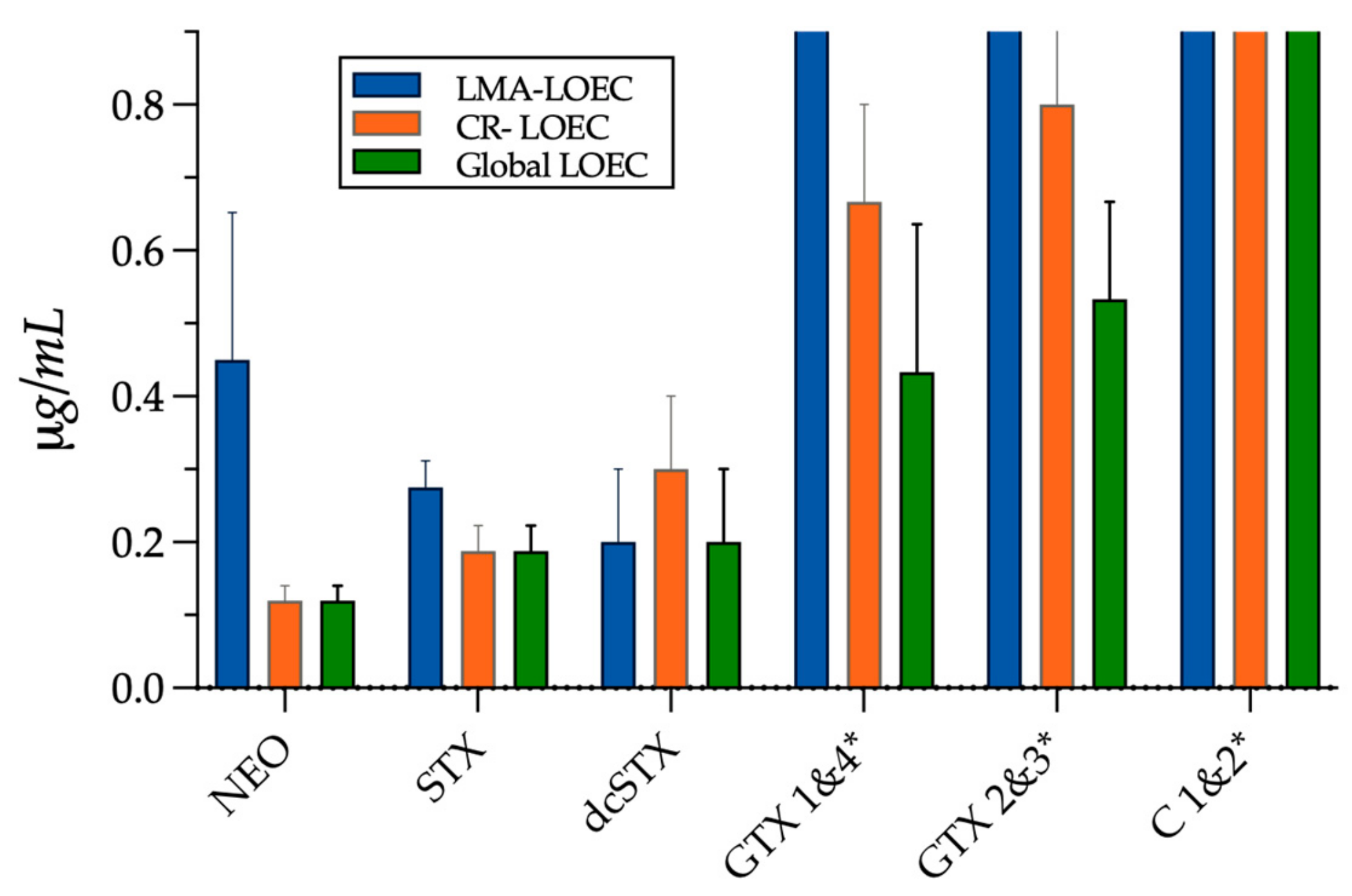A New Bioassay for the Detection of Paralytic and Amnesic Biotoxins Based on Motor Behavior Impairments of Zebrafish Larvae
Abstract
1. Introduction
2. Results and Discussion
2.1. Experimental Condition Setting
2.1.1. Developmental Stage
2.1.2. Time of Day
2.1.3. Group Size and Incubation Volume
2.2. Replicate Number and Controls
2.3. Kinetics of Locomotor Activity in Zebrafish Larvae Exposed to Saxitoxin (STX)
2.4. Complementary Responses of Zebrafish Larvae to STX
2.5. Determination of the Relative Toxic Potency of Other PSP Biotoxins Using the ZebraBioTox Bioassay
| Order of Potency 1 | ZebraBioTox 2 | MBA 3 [43] | In Vitro 4 [44] | MBA 3 [42] |
|---|---|---|---|---|
| 1° | NEO | STX | NEO | STX |
| 2° | STX-dcSTX | NEO-dcSTX | dcSTX-STX | NEO |
| 3° | GTX1&4 | GTX1&4 | GTX1&4 | GTX1–GTX4 |
| 4° | GTX2&3 | GTX2&3 | GTX2&3 | dcSTX |
| 5° | C1&2 | - | C1&2 | GTX2–GTX3 |
2.6. Zebrafish Larvae Responses to Domoic Acid (DA) Exposure
3. Materials and Methods
3.1. Animals
3.2. Chemical and Reagents
3.3. Exposure Solutions and Experimental Groups
3.4. Locomotor Activity Measurement
3.5. Complementary Response Assessment
3.5.1. Body Balance
3.5.2. Periocular Edema
3.5.3. Touch Response
3.5.4. Survival
3.6. Data Processing and Statistical Analysis
3.6.1. Experimental Conditions Data Analysis
3.6.2. LMA Data Analysis
3.6.3. CR Correlation Analysis
3.6.4. Determination of the Minimum Number of Replicates
4. Conclusions
Author Contributions
Funding
Institutional Review Board Statement
Data Availability Statement
Acknowledgments
Conflicts of Interest
References
- Burgess, H.A.; Granato, M. Modulation of locomotor activity in larval zebrafish during light adaptation. J. Exp. Biol. 2007, 210, 2526–2539. [Google Scholar] [CrossRef] [PubMed]
- Basnet, R.M.; Zizioli, D.; Taweedet, S.; Finazzi, D.; Memo, M. Zebrafish larvae as a behavioral model in neuropharmacology. Biomedicines 2019, 7, 23. [Google Scholar] [CrossRef] [PubMed]
- Maeda, H.; Fukushima, N.; Hasumi, A. Standardized method for the assessment of behavioral responses of zebrafish larvae. Biomedicines 2021, 9, 884. [Google Scholar] [CrossRef] [PubMed]
- Rosa, J.G.S.; Lima, C.; Lopes-Ferreira, M. Zebrafish Larvae Behavior Models as a Tool for Drug Screenings and Pre-Clinical Trials: A Review. Int. J. Mol. Sci. 2022, 23, 6647. [Google Scholar] [CrossRef] [PubMed]
- Lefebvre, K.A.; Trainer, V.L.; Scholz, N.L. Morphological abnormalities and sensorimotor deficits in larval fish exposed to dissolved saxitoxin. Aquat. Toxicol. 2004, 66, 159–170. [Google Scholar] [CrossRef]
- Attili, S.; Hughes, S.M. Anaesthetic tricaine acts preferentially on neural voltage-gated sodium channels and fails to block directly evoked muscle contraction. PLoS ONE 2014, 9, e103751. [Google Scholar] [CrossRef]
- Leyden, C.; Brüggemann, T.; Debinski, F.; Simacek, C.A.; Dehmelt, F.A.; Arrenberg, A.B. Efficacy of Tricaine (MS-222) and Hypothermia as Anesthetic Agents for Blocking Sensorimotor Responses in Larval Zebrafish. Front. Vet. Sci. 2022, 9, 864573. [Google Scholar] [CrossRef]
- Kodama. Paralytic Shellfish Poisoning: Ecology, Classification, and Origin. In Seafood and Freshwater Toxins: Pharmacology, Physiology and Detection; Botana, L.M., Ed.; Marcel Dekker: New York, NY, USA, 2000; pp. 125–149. [Google Scholar]
- Vilariño, N.; Louzao, M.C.; Abal, P.; Cagide, E.; Carrera, C.; Vieytes, M.R.; Botana, L.M. Human Poisoning from Marine Toxins: Unknowns for Optimal Consumer Protection. Toxins 2018, 10, 324. [Google Scholar] [CrossRef]
- Zhang, F.; Xu, X.; Li, T.; Liu, Z. Shellfish toxins targeting voltage-gated sodium channels. Mar. Drugs 2013, 11, 4698–4723. [Google Scholar] [CrossRef]
- Suarez-Isla, B.A. Saxitoxin and Other Paralytic Toxins: Toxicological Profile. In Marine and Freshwater Toxins; Gopalakrishnakone, P., Haddad, V., Jr., Kem, W., Tubaro, A., Kim, E., Eds.; Springer: Dordrecht, The Netherlands, 2015. [Google Scholar] [CrossRef]
- Paerl, H.W.; Huisman, J. Climate change: A catalyst for global expansion of harmful cyanobacterial blooms. Environ. Microbiol. Rep. 2009, 1, 27–37. [Google Scholar] [CrossRef]
- Gobler, C.J.; Doherty, O.M.; Hattenrath-Lehmann, T.K.; Griffith, A.W.; Kang, Y.; Litaker, R.W. Ocean warming since 1982 has expanded the niche of toxic algal blooms in the North Atlantic and North Pacific oceans. Proc. Natl. Acad. Sci. USA 2017, 114, 4975–4980. [Google Scholar] [CrossRef] [PubMed]
- Huisman, J.; Codd, G.A.; Paerl, H.W.; Ibelings, B.W.; Verspagen, J.M.H.; Visser, P.M. Cyanobacterial blooms. Nat. Rev. Microbiol. 2018, 16, 471–483. [Google Scholar] [CrossRef] [PubMed]
- Anonymous. AOAC Official Method 2005.06. In Quantitative Determination of Paralytic Shellfish Poisoning Toxins in Shellfish Using Pre-Chromatographic Oxidation and Liquid Chromatography with Fluorescence Detection; AOAC International: Gaithersburg, MD, USA, 2005. [Google Scholar]
- Anonymous. AOAC Official Method 959.08. Paralytic Shellfish Poison. Biological Method. Final Action. Chapter 49: Natural toxins. In AOAC Official Methods for Analysis, 18th ed.; Truckses, M.W., Ed.; AOAC International: Gaithersburg, MD, USA, 2005; pp. 79–80. [Google Scholar]
- Reverté, L.; Soliño, L.; Carnicer, O.; Diogène, J.; Campàs, M. Alternative methods for the detection of emerging marine toxins: Biosensors, biochemical assays and cell-based assays. Mar. Drugs 2014, 12, 5719–5763. [Google Scholar] [CrossRef] [PubMed]
- Wekell, J.C.; Hurst, J.; Lefebvre, K.A. The origin of the regulatory limits for PSP and ASP toxins in shellfish. J. Shellfish Res. 2004, 23, 927–930. [Google Scholar]
- Siracusa, M.; Bacchiocchi, S.; Dubbini, A.; Campacci, D.; Tavoloni, T.; Stramenga, A.; Ciriaci, M.; Dall’Ara, S.; Piersanti, A. A High Throughput Screening HPLC-FLD Method for Paralytic Shellfish Toxins (PSTs) Enabling Effective Official Control. Molecules 2022, 27, 4702. [Google Scholar] [CrossRef]
- Turner, A.D.; Hatfield, R.G.; Rapkova, M.; Higman, W.; Algoet, M.; Suarez-Isla, B.A.; Cordova, M.; Caceres, C.; van de Riet, J.; Gibbs, R.; et al. Comparison of AOAC 2005.06 LC official method with other methodologies for the quantitation of paralytic shellfish poisoning toxins in UK shellfish species. Anal. Bioanal. Chem. 2011, 399, 1257–1270. [Google Scholar] [CrossRef]
- Liang, X.; Souders, C.L., 2nd; Zhang, J.; Martyniuk, C.J. Tributyltin induces premature hatching and reduces locomotor activity in zebrafish (Danio rerio) embryos/larvae at environmentally relevant levels. Chemosphere 2017, 189, 498–506. [Google Scholar] [CrossRef]
- Wang, X.H.; Souders, C.L., 2nd; Zhao, Y.H.; Martyniuk, C.J. Paraquat affects mitochondrial bioenergetics, do-pamine system expression, and locomotor activity in zebrafish (Danio rerio). Chemosphere 2018, 191, 106–117. [Google Scholar] [CrossRef]
- De la Paz, J.F.; Beiza, N.; Paredes-Zúñiga, S.; Hoare, M.S.; Allende, M.L. Triazole Fungicides Inhibit Zebrafish Hatching by Blocking the Secretory Function of Hatching Gland Cells. Int. J. Mol. Sci. 2017, 18, 710. [Google Scholar] [CrossRef]
- Paredes-Zúñiga, S.; Trost, N.; De la Paz, J.F.; Alcayaga, J.; Allende, M.L. Behavioral effects of triadimefon in zebrafish are associated with alterations of the dopaminergic and serotonergic pathways. Prog. Neuro-Psychopharmacol. Biol. Psychiatry 2019, 92, 118–126. [Google Scholar] [CrossRef]
- Guo, R.Y.; Xiang, J.; Wang, L.J.; Li, E.C.; Zhang, J.L. Tributyltin exposure disrupted the locomotor activity rhythms in adult zebrafish (Danio rerio) and the mechanism involved. Aquat. Toxicol. 2022, 251, 106287. [Google Scholar] [CrossRef]
- Prakash, V.; Jain, V.; Chauhan, S.S.; Parthasarathi, R.; Roy, S.K.; Anbumani, S. Developmental toxicity assessment of 4-MBC in Danio rerio embryo-larval stages. Sci. Total Environ. 2022, 804, 149920. [Google Scholar] [CrossRef]
- De Esch, C.; van der Linde, H.; Slieker, R.; Willemsen, R.; Wolterbeek, A.; Woutersen, R.; De Groot, D. Locomotor activity assay in zebrafish larvae: Influence of age, strain and ethanol. Neurotoxicol. Teratol. 2012, 34, 425–433. [Google Scholar] [CrossRef]
- MacPhail, R.C.; Brooks, J.; Hunter, D.L.; Padnos, B.; Irons, T.D.; Padilla, S. Locomotion in larval zebrafish: Influence of time of day, lighting and ethanol. Neurotoxicology 2009, 30, 52–58. [Google Scholar] [CrossRef]
- Wolter, M.E.; Svoboda, K.R. Doing the locomotion: Insights and potential pitfalls associated with using locomotor activity as a readout of the circadian rhythm in larval zebrafish. J. Neurosci. Methods 2020, 330, 108465. [Google Scholar] [CrossRef]
- Pulido, O.M. Domoic acid toxicologic pathology: A review. Mar. Drugs 2008, 6, 180–219. [Google Scholar] [CrossRef]
- Todd, E. Amnesic Shellfish Poisoning—A New Seafood Toxin Syndrome. In Toxic Marine Phytoplankton; Grane, E., Sundstro, B., Edler, L., Eds.; Elsevier: New York, NY, USA, 1990; pp. 504–508. [Google Scholar]
- Bakke, M.J.; Horsberg, T.E. Effects of algal-produced neurotoxins on metabolic activity in telencephalon, optic tectum and cerebellum of Atlantic salmon (Salmo salar). Aquat. Toxicol. 2007, 85, 96–103. [Google Scholar] [CrossRef]
- Tiedeken, J.A.; Ramsdell, J.S.; Ramsdell, A.F. Developmental toxicity of domoic acid in zebrafish (Danio rerio). Neurotoxicol. Teratol. 2005, 27, 711–717. [Google Scholar] [CrossRef]
- Panlilio, J.M.; Jones, I.T.; Salanga, M.C.; Aluru, N.; Hahn, M.E. Developmental Exposure to Domoic Acid Disrupts Startle Response Behavior and Circuitry in Zebrafish. Toxicol. Sci. 2021, 182, 310–326. [Google Scholar] [CrossRef]
- Bichara, D.; Calcaterra, N.B.; Arranz, S.; Armas, P.; Simonetta, S.H. Set-up of an infrared fast behavioral assay using zebrafish (Danio rerio) larvae, and its application in compound biotoxicity screening. J. Appl. Toxicol. 2014, 34, 214–219. [Google Scholar] [CrossRef]
- Granato, M.; van Eeden, F.J.; Schach, U.; Trowe, T.; Brand, M.; Furutani-Seiki, M.; Haffter, P.; Hammerschmidt, M.; Heisenberg, C.P.; Jiang, Y.J.; et al. Genes controlling and mediating locomotion behavior of the zebrafish embryo and larva. Development 1996, 123, 399–413. [Google Scholar] [CrossRef] [PubMed]
- Colwill, R.M.; Creton, R. Locomotor behaviors in zebrafish (Danio rerio) larvae. Behav. Process. 2011, 86, 222–229. [Google Scholar] [CrossRef] [PubMed]
- Thirumalai, V.; Cline, H.T. Endogenous dopamine suppresses initiation of swimming in prefeeding zebrafish larvae. J. Neurophysiol. 2008, 100, 1635–1648. [Google Scholar] [CrossRef] [PubMed]
- Shaw, P.A.G.; Panda, S.K.; Stanca, A.; Luyten, W. Optimization of a locomotion-based zebrafish seizure model. J. Neurosci. Methods 2022, 375, 109594. [Google Scholar] [CrossRef]
- De la Paz, J.F.; Anguita-Salinas, C.; Díaz-Celis, C.; Chávez, F.P.; Allende, M.L. The Zebrafish Perivitelline Fluid Provides Maternally-Inherited Defensive Immunity. Biomolecules 2020, 10, 1274. [Google Scholar] [CrossRef]
- Lefebvre, K.A.; Elder, N.E.; Hershberger, P.K.; Trainer, V.L.; Stehr, C.M.; Scholz, N.L. Dissolved saxitoxin causes transient inhibition of sensorimotor function in larval Pacific herring (Clupea harengus pallasi). Mar. Biol. 2005, 147, 1393–1402. [Google Scholar] [CrossRef]
- Oshima, Y. Postcolumn derivatization liquid chromatographic method for paralytic shellfish toxins. J. AOAC Int. 1995, 78, 528–532. [Google Scholar] [CrossRef]
- Vale, C.; Alfonso, A.; Vieytes, M.R.; Romarís, X.M.; Arévalo, F.; Botana, A.M.; Botana, L.M. In vitro and in vivo evaluation of paralytic shellfish poisoning toxin potency and the influence of the pH of extraction. Anal. Chem. 2008, 80, 1770–1776. [Google Scholar] [CrossRef]
- Perez, S.; Vale, C.; Botana, A.M.; Alonso, E.; Vieytes, M.R.; Botana, L.M. Determination of toxicity equivalent factors for paralytic shellfish toxins by electrophysiological measurements in cultured neurons. Chem. Res. Toxicol. 2011, 24, 1153–1157. [Google Scholar] [CrossRef]
- Westerfield, M. The Zebrafish Book. In A Guide for the Laboratory Use of Zebrafish (Danio rerio), 4th ed.; University of Oregon Press: Eugene, OR, USA, 2009; Available online: https://zfin.org/zf_info/zfbook/cont.html#cont2 (accessed on 1 December 2020).





| CR (%) | Control (-) | Solvent | STX 2.2 µg/mL | STX 1.6 µg/mL | STX 1.2 µg/mL | STX 0.8 µg/mL | STX 0.4 µg/mL | STX 0.2 µg/mL | STX 0.1 µg/mL | |||||||||
| Mortality | 0.0 ± 0 | (20) | 0.0 ± 0 | (10) | 25.0 ± 17.7 | (2) | 9.7 ± 8.7 | (3) | 0.0 ± 0 | (4) | 2.8 ± 4.3 | (6) | 0.0 ± 0 | (10) | 0.0 ± 0 | (9) | 0.0 ± 0 | (9) |
| Periocular edema | 0.0 ± 0 | (20) | 0.0 ± 0 | (10) | 100 ± 0 | (2) | 100 ± 0 | (3) | 100 ± 0 | (4) | 94.4 ± 10.1 | (6) | 66.0 ± 33.8 | (10) | 18.9 ± 31.9 | (9) | 0.0 ± 0 | (9) |
| Abnormal touch response | 0.8 ± 2.6 | (20) | 1.7 ± 5.3 | (10) | 100 ± 0 | (2) | 100 ± 0 | (3) | 100 ± 0 | (4) | 98.6 ± 3.4 | (6) | 83.8 ± 23.8 | (10) | 54.2 ± 39.9 | (9) | 20.5 ± 16.8 | (9) |
| Loss of body balance | 0.8 ± 2.6 | (20) | 2.5 ± 5.6 | (10) | 100 ± 0 | (2) | 100 ± 0 | (3) | 100 ± 0 | (4) | 97.2 ± 6.8 | (6) | 88.3 ± 21.9 | (10) | 51.3 ± 35.4 | (9) | 11.7 ± 10.3 | (9) |
Disclaimer/Publisher’s Note: The statements, opinions and data contained in all publications are solely those of the individual author(s) and contributor(s) and not of MDPI and/or the editor(s). MDPI and/or the editor(s) disclaim responsibility for any injury to people or property resulting from any ideas, methods, instructions or products referred to in the content. |
© 2023 by the authors. Licensee MDPI, Basel, Switzerland. This article is an open access article distributed under the terms and conditions of the Creative Commons Attribution (CC BY) license (https://creativecommons.org/licenses/by/4.0/).
Share and Cite
De la Paz, J.F.; Zambrano, N.O.; Ortiz, F.C.; Llanos-Rivera, A. A New Bioassay for the Detection of Paralytic and Amnesic Biotoxins Based on Motor Behavior Impairments of Zebrafish Larvae. Int. J. Mol. Sci. 2023, 24, 7466. https://doi.org/10.3390/ijms24087466
De la Paz JF, Zambrano NO, Ortiz FC, Llanos-Rivera A. A New Bioassay for the Detection of Paralytic and Amnesic Biotoxins Based on Motor Behavior Impairments of Zebrafish Larvae. International Journal of Molecular Sciences. 2023; 24(8):7466. https://doi.org/10.3390/ijms24087466
Chicago/Turabian StyleDe la Paz, Javiera F., Nicolás O. Zambrano, Fernando C. Ortiz, and Alejandra Llanos-Rivera. 2023. "A New Bioassay for the Detection of Paralytic and Amnesic Biotoxins Based on Motor Behavior Impairments of Zebrafish Larvae" International Journal of Molecular Sciences 24, no. 8: 7466. https://doi.org/10.3390/ijms24087466
APA StyleDe la Paz, J. F., Zambrano, N. O., Ortiz, F. C., & Llanos-Rivera, A. (2023). A New Bioassay for the Detection of Paralytic and Amnesic Biotoxins Based on Motor Behavior Impairments of Zebrafish Larvae. International Journal of Molecular Sciences, 24(8), 7466. https://doi.org/10.3390/ijms24087466






